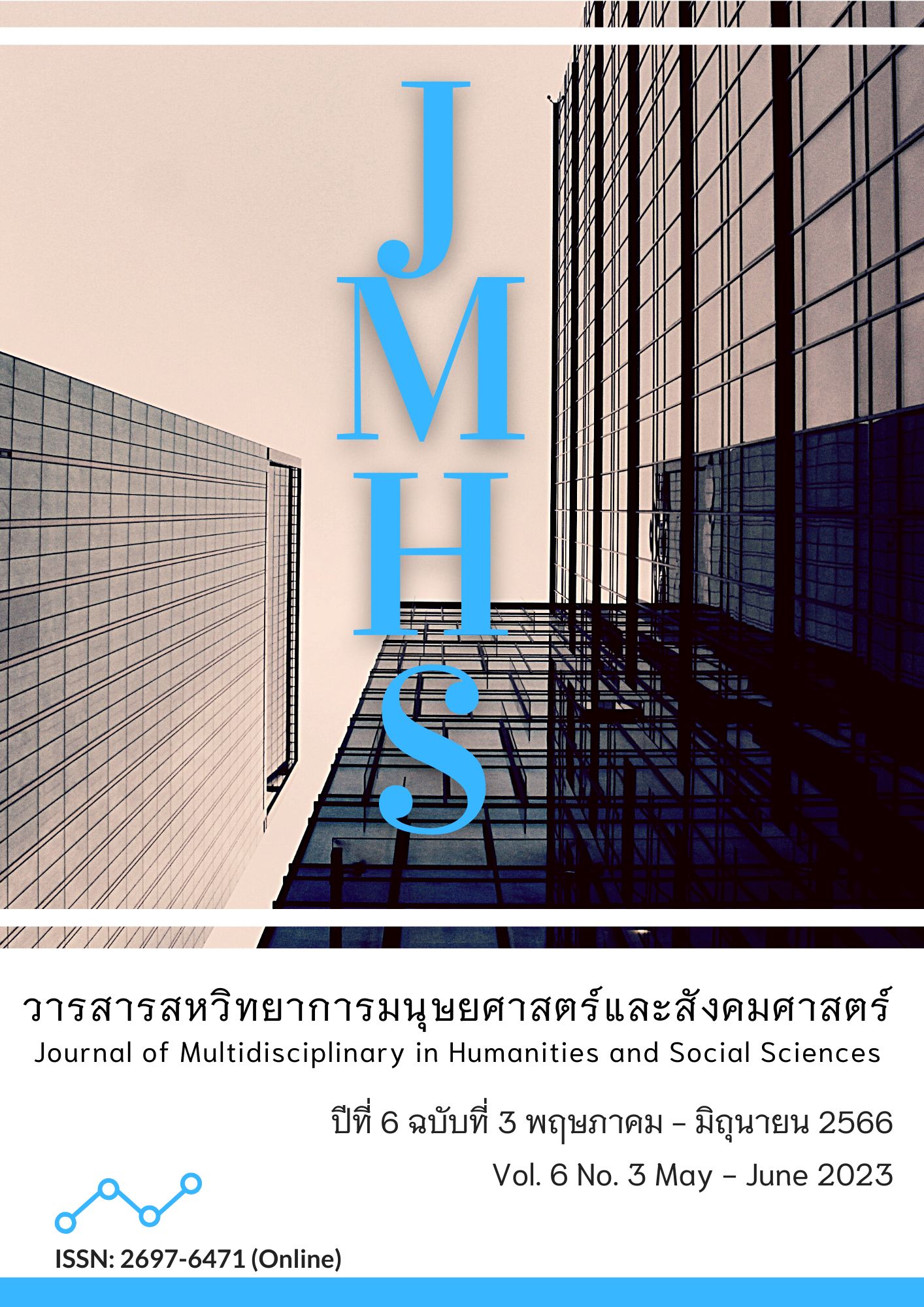Causal Factors Influencing Repurchase Intention for Mom and Kid Products on Shopee Application of Consumers in Bangkok and Its Vicinity
Main Article Content
Abstract
The article aimed to 1) develop and validate a causal relationship model of repurchase intention for mom and kid products on the Shopee application of consumers in Bangkok and its vicinity, and 2) study causal factors influencing mom and kid products repurchase intention via the Shopee application of consumers in Bangkok and its vicinity. This study was quantitative research. The sample consisted of 426 people who had bought mom and kid products via the Shopee application and lived in Bangkok and its vicinity of 426 people by convenience sampling. The tools used in the research were online questionnaires. The statistics used in data analysis were frequency, percentage, confirmatory factor analysis, and the structural equation model.
The results of this research were the development of causal relationship models consisting of 5 components: 1) e-service quality; 2) price perception; 3) experiential marketing; 4) customer satisfaction; and 5) repurchase intention, and the model is consistent with the empirical data to a great extent. The statistics showed CMIN/df = 1.79, GFI = 0.93, AGFI = 0.90, SRMR = 0.05, and RMSEA = 0.04. The final predictive coefficient was 0.77, indicating that the variables in the model can explain the variance of the repurchase intention on the Shopee application by 77 percent. It was found that customer satisfaction was influenced, respectively, by repurchasing intentions for mom and kid products on the Shopee application. The results of this research are useful for entrepreneurs. Mom and kid products businesses can utilize them to create marketing plans and create marketing strategies by considering customer satisfaction.
Article Details

This work is licensed under a Creative Commons Attribution-NonCommercial-NoDerivatives 4.0 International License.
Views and opinions appearing in the Journal it is the responsibility of the author of the article, and does not constitute the view and responsibility of the editorial team.
References
กรองกาญจน์ พึ่งแก้ว, อรุณรุ่ง วงศ์กังวาน, ณัฐพงษ์ เตชะรัตนเสฏฐ์ และ ปราณี ตรีทศกุล. (2562). ส่วนประสมทางการตลาดบริการ การรับรู้คุณค่าตราสินค้า และพฤติกรรมการซื้อของลูกค้าผ่านแอพพลิเคชั่นช้อปปี้ (Shopee). วารสารวิจัยราชภัฏธนบุรี รับใช้สังคม, 5(1), 107-119. สืบค้นจาก https://so02.tci-thaijo.org/index.php/DRURDI/article/view/252153
กฤษฎา ฟักสังข์ และ สมชาย เล็กเจริญ. (2564). ปัจจัยเชิงสาเหตุที่มีอิทธิพลต่อความตั้งใจซื้อซ้ำแพ็กเกจทัวร์ผ่านแอปพลิเคชันอโกด้าของผู้บริโภคในเขตกรุงเทพมหานครและปริมณฑล. วารสารวิชาการ มหาวิทยาลัยหอการค้าไทย มนุษยศาสตร์และสังคมศาสตร์, 41(3), 37-55. สืบค้นจาก https://so06.tci-thaijo.org/index.php/utccjournalhs/article/view/246946
กันทลัส ทองบุญมา. (2564). การประยุกต์ใช้เทคโนโลยีความจริงเสริมในการตลาดเชิงประสบการณ์. วารสารนิเทศสยามปริทัศน์, 20(1), 102-118. สืบค้นจาก https://so05.tci-thaijo.org /index.php/commartsreviewsiamu/article/view/250781
ฐานิดา สุริยะวงศ์, วัชระ เวชประสิทธิ์ และ วิวิศณ์ สุขแสงอร่าม. (2565). ความสัมพันธ์เชิงสาเหตุของคุณภาพการบริการทางอิเล็กทรอนิกส์และประสบการณ์ลูกค้าที่มีต่อความพึงพอใจและความภักดีของลูกค้าธุรกิจจาหน่ายสินค้าแฟชั่นออนไลน์. วารสารบริหารศาสตร์ มหาวิทยาลัยอุบลราชธานี, 11(2), 118-139. สืบค้นจาก https://so03.tci-thaijo.org/index.php/jms_ubu/article/view/259222
ณัฐพล อัสสะรัตน์ และ อธิวัฒน์ รัตนพันธ์. (2563). อิทธิพลคุณภาพบริการและการรับรู้ราคาของศูนย์บริการรถยนต์ต่อความพึงพอใจ การบอกต่อ และการซื้อซ้ำในแบรนด์รถยนต์. BU Academic Review, 19(1), 31-47. สืบค้นจาก https://so01.tci-thaijo.org/index.php/buacademicreview/article/view/216003
ธัญญ์นภัส ภูวนันท์ทวีสิน, เพชรรัตน์ วิริยะสืบพงศ์ และ สานนท์ อนันทานนท์. (2565). ปัจจัยทางด้านตราสินค้าที่มีอิทธิพลต่อการซื้อซ้ำ โดยการวิเคราะห์ห่วงโซ่คุณค่าผลิตภัณฑ์ผลไม้แปรรูปในภาคตะวันออก: กรณีศึกษาทุเรียน. วารสารวิชาการ มหาวิทยาลัยกรุงเทพธนบุรี, 11(2), 1-15. สืบค้นจาก https://so01.tci-thaijo.org/index.php/bkkthon/article/view/257963
ธัญยธรณ์ นพสิทธิพันธ์, ประยงค์ มีใจซื่อ และ แก้วตา ผู้พัฒนพงศ์. (2562). ผลกระทบของความพึงพอใจของลูกค้าและบุพปัจจัยที่มีผลต่อความจงรักภักดีของลูกค้าสายการบินต้นทุนต่ำ. วารสารดุษฎีบัณฑิตทางสังคมศาสตร์, 9(2), 277-289. สืบค้นจาก https://so05.tci-thaijo.org /index.php/phdssj/article/view/115762
ปัณฒิฌา ธรรมกุลธารี และ สมชาย เล็กเจริญ. (2564). ปัจจัยเชิงสาเหตุที่มีอิทธิพลต่อความตั้งใจซื้อซ้ำเสื้อผ้านแฟชั่นผ่านแอปพลิเคชันโพเมโลของผู้บริโภคในเขตกรุงเทพมหานครและปริมณฑล. วารสารวิชาการ มหาวิทยาลัยหอการค้าไทย มนุษยศาสตร์และสังคมศาสตร์, 41(2), 110-126. สืบค้นจาก https://so06.tci-thaijo.org/index.php/utccjournalhs/article/view/246206
ฝนริน ชนะกำโชคเจริญ และ วงศ์ลัดดา วีระไพบูลย์. (2564). ปัจจัยเชิงผลลัพธ์ตลาดเชิงประสบการณ์ของนักท่องเที่ยวชาวไทยที่มาเยือนพิพิธภัณฑ์มิวเซียมสยาม. วารสารวิชาการการท่องเที่ยวไทยนานาชาติ, 17(1), 81-103. สืบค้นจาก https://so02.tci-thaijo.org/index.php/jitt/article/view/246941
พีรวิชญ์ ธีระกาญจน์ และ สุรสิทธิ์ อุดมธนวงศ์. (2562). อิทธิพลของการรับรู้คุณค่าและการตระหนักรู้ตราสินค้าที่ส่งผลต่อการซื้อซ้ำของผลิตภัณฑ์ซีเรียลผ่านช่องทางออนไลน์ของผู้บริโภคในเขตกรุงเทพมหานคร. วารสารบริหารธุรกิจ มหาวิทยาลัยแม่โจ้, 1(2), 60-71. สืบค้นจาก https://so05.tci-thaijo.org/index.php/MJBA/article/view/255219
วรรณพร จิตรสังวรณ์. (2564). ประสิทธิภาพระบบเชาห้องอัดเสียงและอุปกรณดนตรีผ่านอินเทอร์เน็ตโดยใชแนวคิดคุณภาพบริการอิเล็กทรอนิกส์. วารสารวิทยาศาสตร์และเทคโนโลยี วิทยาลัยเซาธ์อีสท์บางกอก, 1(1),15-25. สืบค้นจาก https://ph02.tci-thaijo.org/index.php/JSCI/article/view/243615
เว็บไซต์ Positioning. (2564, 24 ธันวาคม). ตลาด “แม่และเด็ก” ยังเติบโตแม้จำนวนเด็กเกิดใหม่ลดลง ผลิตภัณฑ์พรีเมียม-ออร์แกนิคมาแรง. สืบค้นเมื่อ 17 ตุลาคม 2565, จาก https://positioningmag.com/1368682
สุมามาลย์ ปานคํา และ ณัฐยุพา ทิวากรโกมล. (2564). ปัจจัยเชิงสาเหตุที่มีผลต่อความตั้งใจซื้อซ้ำตั๋วเครื่องบินผ่านเว็บไซต์สายการบินนกแอร์ของผู้บริโภคในเขตกรุงเทพมหานครและปริมณฑล. วารสารสหวิทยาการมนุษยศาสตร์และสังคมศาสตร์, 4(2), 506-520. สืบค้นจาก https://so04.tci-thaijo.org/index.php/jmhs1_s/article/view/249626
สำนักงานพัฒนาธุรกรรมทางอิเล็กทรอนิกส์. (2564, 10 มิถุนายน). e-Commerce ไทย ยุคหลัง COVID-19. สืบค้นเมื่อ 17 ตุลาคม 2565, จาก https://www.etda.or.th/th/Useful-Resource/Knowledge-Sharing/Perspective-on-Future-of-e-Commerce.aspx
สำนักงานพัฒนาธุรกรรมทางอิเล็กทรอนิกส์. (2565, 21 สิงหาคม). รายงานผลการสำรวจพฤติกรรมผู้ใช้อินเทอร์เน็ตในประเทศไทย ปี 2565. สืบค้นเมื่อ 9 กุมภาพันธ์ 2566, จาก https://www.etda.or.th/getattachment/78750426-4a58-4c36-85d3-d1c11c3db1f3/IUB-65-Final.pdf.aspx
อันธิกา หยองอนุกูล และ สุมามาลย์ ปานคำ. (2565). ปัจจัยเชิงสาเหตุที่มีผลต่อความตั้งใจซื้อซ้ำสินค้าบนเว็บไซต์ซูเปอร์มาร์เก็ตของผู้บริโภคในเขตกรุงเทพมหานครและปริมณฑล. วารสารบัณฑิตศาส์น มหาวิทยาลัยมหามกุฏราชวิทยาลัย, 20(1), 49-60. สืบค้นจาก https://so04.tci-thaijo.org/index.php/mgsj/article/view/259596
Aditama, R.R.A., & Haryono, T. (2022). The Effect of Experiential Marketing on Repurchase Intention with Customer Satisfaction Mediation and Reputable Brand at Self Cooking Restaurant. International Journal of Economics, Business and Accounting Research, 6(1), 553-561. Retrieved from https://jurnal.stie-aas.ac.id/index.php/IJEBAR/article/view/4784
Dinesh, S., & Raju, Y.M. (2022). Impact of E-service Quality and Price Perception on Customer Satisfaction and Repurchases Intention. International Journal of Current Advanced Research. 11(7), 1152-1156. Retrieved from https://www.researchgate.net/publication/363172825
Hair, J. F., Black, W. C., Babin, B. J., & Anderson, R. E. (2010). Multivariate Data Analysis (7th ed.). Upper Saddle River, NJ: Prentice Hall.
Hair, J. F., Hult, G. T. M., Ringle, C. M., & Sarstedt, M. (2014). A Primer on Partial Least Squares Structural Equation Modeling (PLS-SEM). California, CA: Sage Publications.
Hoelter, J. W. (1983). The Effects of Role Evaluation and Commitment on Identity Salience. Social Psychology Quarterly, 46(2), 140–147. https://doi.org/10.2307/3033850
Hu, L.T., & Bentler, P. M. (1999). Cutoff Criteria for Fit Indexes in Covariance Structure Analysis: Conventional Criteria Versus New Alternatives. Structural Equation Modeling, 6(1), 1–55. https://doi.org/10.1080/10705519909540118
Joreskog, K. G., & Sorbom, D. (1984). Advances in Factor Analysis and Structural Equation Models. Lanham: Rowman & Littlefield Publishers.
Kline, R. B. (2011). Principles and Practices of Structural Equation Modeling (3rd ed.). New York: The Guilford Press.
Schreiber, J. B., Stage, F. K., King, J., Nora, A., & Barlow, E. A. (2006). Reporting Structural Equation Modeling and Confirmatory Factor Analysis Results: A Review. The Journal of Educational Research, 99(6), 323–337. https://doi.org/10.3200/JOER.99.6.323-338
Schumacker, R. E., & Lomax, R. G. (2004). A Beginner's Guide to Structural Equation Modeling (2nd ed.). Lawrence Erlbaum Associates Publishers.
Suhaily, L., & Soelasih, Y. (2017). What Effect Repurchase Intention of Online Shopping. International Business Research, 10(12), 113-122. https://doi.org/10.5539/ibr.v10n12p113
Thompson, B. (2004). Exploratory and Confirmatory Factor Analysis: Understanding Concepts and Applications. American Psychological Association.
Ullman, M. T. (2001). The Declarative/Procedural Model of Lexicon and Grammar. Journal of Psycholinguistic Research, 30(1), 37–69. https://doi.org/10.1023/A:1005204207369


